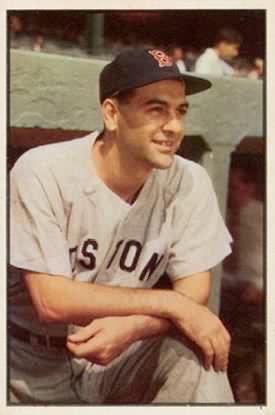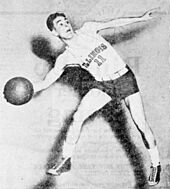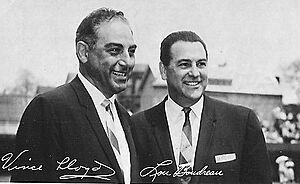Lou Boudreau facts for kids
Quick facts for kids Lou Boudreau |
|||||||||||||||||||||||||||||||||
|---|---|---|---|---|---|---|---|---|---|---|---|---|---|---|---|---|---|---|---|---|---|---|---|---|---|---|---|---|---|---|---|---|---|

Boudreau with the Boston Red Sox in 1953
|
|||||||||||||||||||||||||||||||||
| Shortstop / Manager | |||||||||||||||||||||||||||||||||
| Born: July 17, 1917 Harvey, Illinois, U.S. |
|||||||||||||||||||||||||||||||||
| Died: August 10, 2001 (aged 84) Olympia Fields, Illinois, U.S. |
|||||||||||||||||||||||||||||||||
|
|||||||||||||||||||||||||||||||||
| debut | |||||||||||||||||||||||||||||||||
| September 9, 1938, for the Cleveland Indians | |||||||||||||||||||||||||||||||||
| Last appearance | |||||||||||||||||||||||||||||||||
| August 24, 1952, for the Boston Red Sox | |||||||||||||||||||||||||||||||||
| MLB statistics | |||||||||||||||||||||||||||||||||
| Batting average | .295 | ||||||||||||||||||||||||||||||||
| Home runs | 68 | ||||||||||||||||||||||||||||||||
| Runs batted in | 789 | ||||||||||||||||||||||||||||||||
| Managerial record | 1,162–1,224 | ||||||||||||||||||||||||||||||||
| Winning % | .487 | ||||||||||||||||||||||||||||||||
| Teams | |||||||||||||||||||||||||||||||||
As player
As manager
|
|||||||||||||||||||||||||||||||||
| Career highlights and awards | |||||||||||||||||||||||||||||||||
|
|||||||||||||||||||||||||||||||||
| Induction | 1970 | ||||||||||||||||||||||||||||||||
| Vote | 77.3% (tenth ballot) | ||||||||||||||||||||||||||||||||
|
|||||||||||||||||||||||||||||||||
Louis Boudreau (born July 17, 1917 – died August 10, 2001) was an amazing American baseball player and manager. People called him "Old Shufflefoot" or "Handsome Lou." He played in Major League Baseball (MLB) for 15 seasons. He was mostly a shortstop for the Cleveland Indians.
Boudreau also managed baseball teams for 15 seasons. For 10 of those years, he was a player-manager. This means he played on the team and managed it at the same time! After his baseball career, he became a radio announcer for the Chicago Cubs. In college, he was a star in both baseball and basketball. He was even named an NCAA Men's Basketball All-American for the University of Illinois.
Lou Boudreau was chosen for the All-Star Game seven times. In 1948, he won the American League Most Valuable Player Award. That same year, he led the Cleveland Indians to win the World Series. He also won the American League (AL) batting title in 1944. He led the league in doubles three times. Boudreau still holds an MLB record for hitting four doubles in one game.
In 1970, Boudreau was voted into the National Baseball Hall of Fame. The Cleveland Indians also retired his jersey number 5 that year.
Contents
Early Life and School Days
Lou Boudreau was born in Harvey, Illinois. His parents were Birdie and Louis Boudreau. He grew up Catholic. He went to Thornton Township High School in Harvey. There, he was a basketball star. He led his team, the "Flying Clouds," to three state championship games. They won in 1933.
College Sports Career
Boudreau attended the University of Illinois at Urbana–Champaign. He was a member of a fraternity called Phi Sigma Kappa. He was also the captain of both the basketball and baseball teams. In 1936–37, he helped both teams win the Big Ten Conference championship. The next year, he was named an All-American in basketball.
While still in college, the Cleveland Indians baseball team offered him money. They wanted him to play for them after he graduated. Because of this, college officials said he could not play college sports anymore. During his last year at Illinois, he played professional basketball. He played for the Hammond Ciesar All-Americans.
Even though he was playing pro baseball, Boudreau finished his degree. He earned a Bachelor of Science in education in 1940. He also coached the Illinois freshman basketball teams in 1939 and 1940. He even helped recruit future Hall of Famer Andy Phillip to play for Illinois.
Professional Baseball Journey
Playing for the Cleveland Indians
Lou Boudreau started his MLB career on September 9, 1938. He was 21 years old. He first played as a third baseman for the Cleveland Indians. In 1939, his manager told him to switch to shortstop. This was because another great player, Ken Keltner, was already the team's third baseman.
In 1940, Boudreau played his first full season. He hit for a .295 average. He also had 46 doubles and 101 RBI. He was chosen for the All-Star Game five years in a row.
In 1941, Boudreau helped stop a famous streak. Joe DiMaggio had hit safely in 56 games in a row. Boudreau made a great play at shortstop. He grabbed a tricky ground ball with his bare hand. Then he started a double play that got DiMaggio out. This ended DiMaggio's amazing hitting streak.
After the 1941 season, Boudreau became a player-manager. He was only 25 years old! He played and managed the Indians during World War II. Boudreau had arthritis in his ankles. This meant he could not join the military. In 1944, he helped turn 134 double plays. This is still the most ever by a player-manager.
In 1947, a new owner, Bill Veeck, bought the Indians. Boudreau convinced Veeck to let him stay as player-manager. In 1948, Boudreau had an amazing year. He hit .355. The Cleveland Indians won the AL pennant. Then they won the World Series. It was the Indians' first World Series win in 28 years.
Later Career as Player and Manager
After the 1950 season, the Indians let Boudreau go. He then joined the Boston Red Sox. He played full-time in 1951. In 1952, he became their player-manager. He managed the Red Sox until 1954.
Next, he became the first manager for the Kansas City Athletics in 1955. He managed them until 1957. His last managing job was for the Chicago Cubs in 1960.
Managerial Record Summary
Lou Boudreau managed teams for many years. His overall record was 1,162 wins and 1,224 losses. This means his teams won 48.7% of their games. His best year was 1948. That year, his Cleveland Indians won the World Series.
The "Boudreau Shift" in Baseball
Lou Boudreau is famous for inventing a special defense strategy. It's called the "Boudreau shift." He used it against Red Sox superstar Ted Williams. Williams was a "dead-pull hitter." This means he almost always hit the ball to the right side of the field.
So, Boudreau moved most of his Cleveland Indian fielders to the right of second base. Only the third baseman and left fielder stayed on the left side. They also played very close to second base. Williams was a great hitter. He usually refused to hit or bunt to the left side.
Boudreau later said the shift was mostly a mind game. He wanted to make Williams think about it. He wrote in his book that the shift was more "psychological" than a real tactic.
Life After Playing: Broadcasting
After managing, Boudreau became a baseball announcer. He did play-by-play for Cubs games from 1958 to 1959. He managed the Cubs for one season in 1960. Then he went back to the radio booth. He stayed there until 1987.
He also announced games for other sports teams. He worked for the Chicago Bulls basketball team from 1966 to 1968. He also announced games for the Chicago Blackhawks hockey team.
Boudreau's knowledge of the rules once changed a game. On June 23, 1976, the Cubs were losing a game. The umpires stopped the game because it was getting dark. They said the game would continue the next day. But Boudreau knew the rules better. He told the umpires that the game had not gone long enough to be stopped and continued later. The umpires called the league office. They found out Boudreau was right! The game had to be replayed from the beginning. This saved the Cubs from their deficit.
Honors and Legacy
 |
|
| Lou Boudreau's number 5 was retired by the Cleveland Indians in 1970. |
In 1970, Lou Boudreau was elected to the Baseball Hall of Fame. That same year, the Cleveland Indians retired his jersey number 5. This means no other player on the team can wear that number. A street near Cleveland Municipal Stadium was renamed Boudreau Drive. There is also a Boudreau Drive in Urbana, Illinois.
In 1990, the Cleveland Indians started an award in his name. The Lou Boudreau Award is given each year. It honors the best minor league player in their organization. In 1992, his number 5 jersey was also retired by the Illinois Fighting Illini baseball program. He is one of only three Illinois athletes to have their number retired.
Family Life
Lou Boudreau married Della DeRuiter in 1938. They had four children together. His daughter Sharyn married Denny McLain. McLain was a famous pitcher for the Detroit Tigers. He was the last pitcher to win 30 games in a season.
Lou Boudreau lived in Frankfort, Illinois, for many years. He passed away on August 10, 2001. He was 84 years old. He died from a heart issue in Olympia Fields, Illinois. He was buried in Pleasant Hill Cemetery.
See also
- List of Major League Baseball batting champions
- List of Major League Baseball annual doubles leaders
- List of Major League Baseball player-managers
- List of Major League Baseball managers by wins



